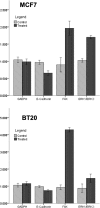Water-pipe smoking promotes epithelial-mesenchymal transition and invasion of human breast cancer cells via ERK1/ERK2 pathways
- PMID: 30473629
- PMCID: PMC6234648
- DOI: 10.1186/s12935-018-0678-9
Water-pipe smoking promotes epithelial-mesenchymal transition and invasion of human breast cancer cells via ERK1/ERK2 pathways
Abstract
Background: With the increasing popularity of water-pipe smoking (WPS), it is critical to comprehend how WPS may affect women's health. The main goal of this study is to identify the potential outcome of WPS on human breast cancer progression.
Methods: Two breast cancer cell lines, MCF7 and BT20, were used in this investigation. We explored the outcome of WPS on cell morphology and cell invasion using inverted microscope and Biocoat Matrigel invasion chambers. On the other hand, Western blot was employed to study the expression patterns of key control genes of cell adhesion and invasion.
Results: Our data reveal that WPS induces epithelial-mesenchymal transition (EMT) of MCF7 and BT20 breast cancer cell lines; thus, WPS enhances cell invasion ability of both cell lines in comparison with their matched controls. More significantly, WPS provokes a down- and up-regulation of E-cadherin and focal adhesion kinase (FAK), respectively, which are important key regulators of cancer progression genes. Finally, our data point out that WPS incites the activation of Erk1/Erk2, which could be behind the stimulation of EMT and invasion as well as the deregulation of E-cadherin and FAK expression.
Conclusion: Our data show, for the first time, that WPS initiates EMT and stimulates cell invasion of breast cancer cells, which could incite metastatic development in breast cancer patients. Thus, we believe that further studies, both in vitro and in vivo, are required to elucidate the pathogenic outcome of WPS on cancer progression of several human carcinomas including breast.
Keywords: Breast cancer; Cell adhesion; Cell invasion; EMT; Erk1/Erk2 pathways; Water-pipe smoking.
Figures





Similar articles
-
Water-Pipe Smoking Exposure Deregulates a Set of Genes Associated with Human Head and Neck Cancer Development and Prognosis.Toxics. 2020 Sep 18;8(3):73. doi: 10.3390/toxics8030073. Toxics. 2020. PMID: 32961854 Free PMC article.
-
Substantial Toxic Effect of Water-Pipe Smoking on the Early Stage of Embryonic Development.Nicotine Tob Res. 2018 Mar 6;20(4):502-507. doi: 10.1093/ntr/ntx135. Nicotine Tob Res. 2018. PMID: 28605482
-
Oncoproteins of High-Risk HPV and EBV Cooperate to Enhance Cell Motility and Invasion of Human Breast Cancer Cells via Erk1/Erk2 and β-Catenin Signaling Pathways.Front Oncol. 2021 Mar 12;11:630408. doi: 10.3389/fonc.2021.630408. eCollection 2021. Front Oncol. 2021. Retraction in: Front Oncol. 2021 Sep 07;11:759578. doi: 10.3389/fonc.2021.759578. PMID: 33777781 Free PMC article. Retracted.
-
Preventing and controlling water pipe smoking: a systematic review of management interventions.BMC Public Health. 2021 Feb 26;21(1):344. doi: 10.1186/s12889-021-10306-w. BMC Public Health. 2021. PMID: 33632181 Free PMC article.
-
The growing epidemic of water pipe smoking: health effects and future needs.Respir Med. 2014 Sep;108(9):1241-53. doi: 10.1016/j.rmed.2014.07.014. Epub 2014 Aug 7. Respir Med. 2014. PMID: 25130679 Review.
Cited by
-
Effect of Water-Pipe Smoking on the Normal Development of Zebrafish.Int J Environ Res Public Health. 2021 Nov 6;18(21):11659. doi: 10.3390/ijerph182111659. Int J Environ Res Public Health. 2021. PMID: 34770174 Free PMC article.
-
Periductal Mastitis Occurring Among Hubble-Bubble Smokers: A Report of Two Cases and Literature Review.Cureus. 2024 Dec 14;16(12):e75686. doi: 10.7759/cureus.75686. eCollection 2024 Dec. Cureus. 2024. PMID: 39811207 Free PMC article.
-
E-Cigarette Liquid Provokes Significant Embryotoxicity and Inhibits Angiogenesis.Toxics. 2020 May 27;8(2):38. doi: 10.3390/toxics8020038. Toxics. 2020. PMID: 32471135 Free PMC article.
-
Possible involvement of TGF‑β‑SMAD‑mediated epithelial‑mesenchymal transition in pro‑metastatic property of PAX6.Oncol Rep. 2020 Aug;44(2):555-564. doi: 10.3892/or.2020.7644. Epub 2020 Jun 11. Oncol Rep. 2020. PMID: 32627030 Free PMC article.
-
Water-Pipe Smoking Exposure Deregulates a Set of Genes Associated with Human Head and Neck Cancer Development and Prognosis.Toxics. 2020 Sep 18;8(3):73. doi: 10.3390/toxics8030073. Toxics. 2020. PMID: 32961854 Free PMC article.
References
LinkOut - more resources
Full Text Sources
Miscellaneous

